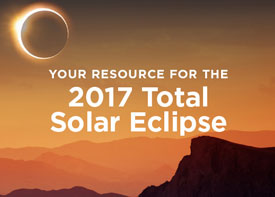 Transitions Optical released a toolkit
Transitions Optical released a toolkit
with resources for ECPs.As VMail previously reported, organizations and associations such as the American Optometric Association (AOA), the American Academy of Ophthalmology (AAO), the American Astronomical Society (AAS) and the National Aeronautics and Space Administration (NASA), among others, have issued tips on how the public can view the eclipse safely.
NASA in particular, warns against purchasing eclipse glasses from Amazon because they are not guaranteed to be safe. After reports that unsafe, paper solar glasses were being distributed, the organization issued a flyer that indicates ways to know that your glasses are safe. Exposing your eyes without proper eye protection during a solar eclipse, Prevent Blindness reports, can cause “eclipse blindness” or retinal burns, also known as solar retinopathy.
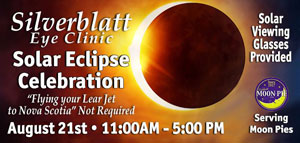 Silverblatt Eye Clinic will host a viewing celebration.
Silverblatt Eye Clinic will host a viewing celebration.In conjunction with the celebration, Silverblatt Eye Clinic’s boutique, Styleyes Eyewear Boutique will also be holding a Krewe Eyewear trunk show from 11 am to 5 pm. Every pair of Krewe glasses comes with a lifetime warranty and mirrored, polarized, rounded and rose gold options will be available.
For those who will not be attending the celebration, Silverblatt Eye Clinic warns against the use of ordinary glasses or homemade filters as these will not sufficiently protect the eye during the experience. Watching a solar eclipse through any other device that is not made for such a purpose can cause serious injury to eyes, the practice stated.
Alabama’s Schaeffer Eye Center, Washington’s Wallingford Eye Care and New York’s Hudson River Eye Care are among other ECPs who have taken to social media to promote awareness.
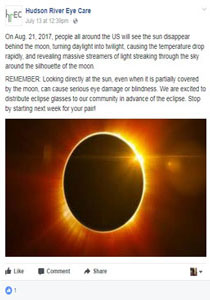 | 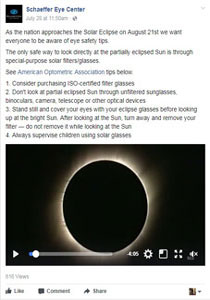 | 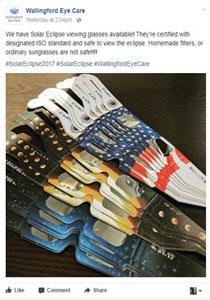 |
| Hudson River Eye Care reminds patients not to look directly at the sun. | Schaeffer Eye Center posts
tips by the AOA. | Wallingford Eye Care tells their patients of their eclipse viewing glasses. |
Schaeffer Eye Center posted the AOA’s safety tips onto their Facebook page, which reminded patients that cameras, binoculars, telescopes or other optical devices are also not safe for viewing the eclipse. Wallingford Eye Care and Hudson River Eye Care have both alerted their patients that ISO-certified eclipse viewing glasses are available at their stores.
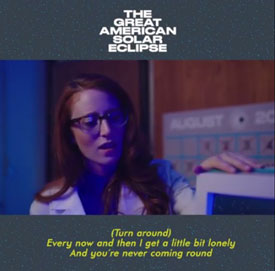 Warby Parker held a contest and posted a
Warby Parker held a contest and posted a
rendition of “Solar Eclipse of the Heart.”Since the company will also be hosting a viewing party at the location, they decided to hold “The Warby Parker Great American Solar Eclipse Sweepstakes” to fly one contestant and a guest to their Nashville store. The winner of the sweepstakes was selected at random and notified yesterday. Watch their remake of “Solar Eclipse of the Heart,” here.
For their part, Transitions Optical is helping ECPs reach their communities. The company released new resources for eyecare professionals so they are prepared to share excitement of the eclipse by talking about sun protection with their patients and local media during the eclipse and year-round.
The materials found at Transitions.com, provide ECPs with messaging, PR tips and marketing resources. The toolkit includes an eclipse fact sheet, media outreach materials, an office counter card and social media content, among other resources.
Zeiss also launched the Zeiss Eclipse 2017 microsite which is intended to aid eyecare professionals, photographers, space buffs and eclipse fans in experiencing the eclipse either in-person or online. The site features tips on safely viewing the eclipse, articles from Mike Morris, OD, a self-proclaimed eclipse chaser, and information for entering the Zeiss eclipse photo contest on Instagram. More information on the contest can be found here.
Since most states in the U.S. will only get a partial eclipse, Vox.com has an eclipse animation that relies on data provided by the U.S. Naval Observatory and allows the viewer to see when the eclipse peaks in their respective state and what percentage of the eclipse they’ll get to see.
Places such as Salem, Ore. and Idaho Falls, Idaho will get a total eclipse, while Lake Charles, La. and Chicago will get a partial eclipse. Find out if you are in the path of totality here.